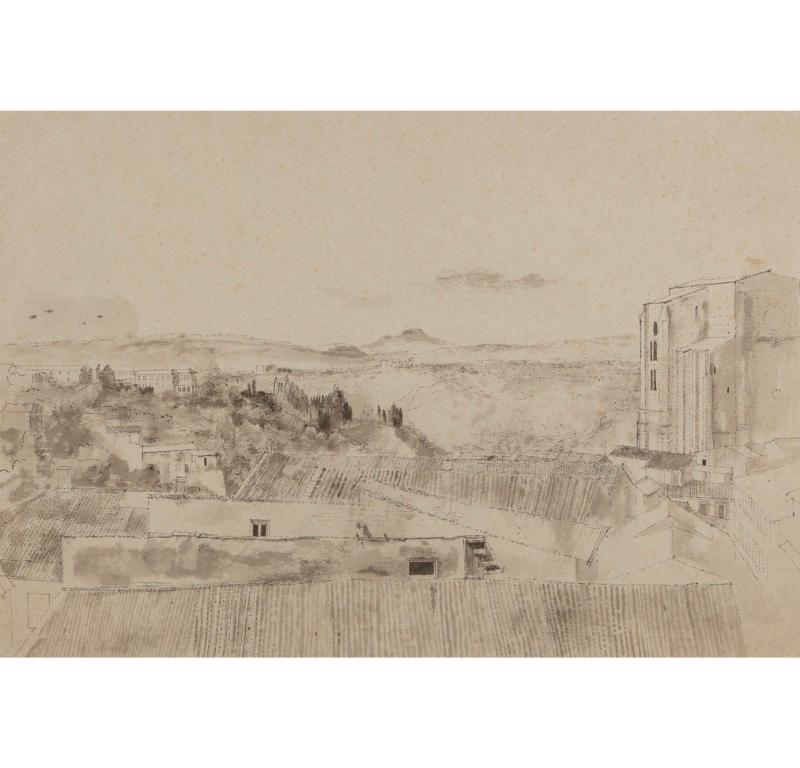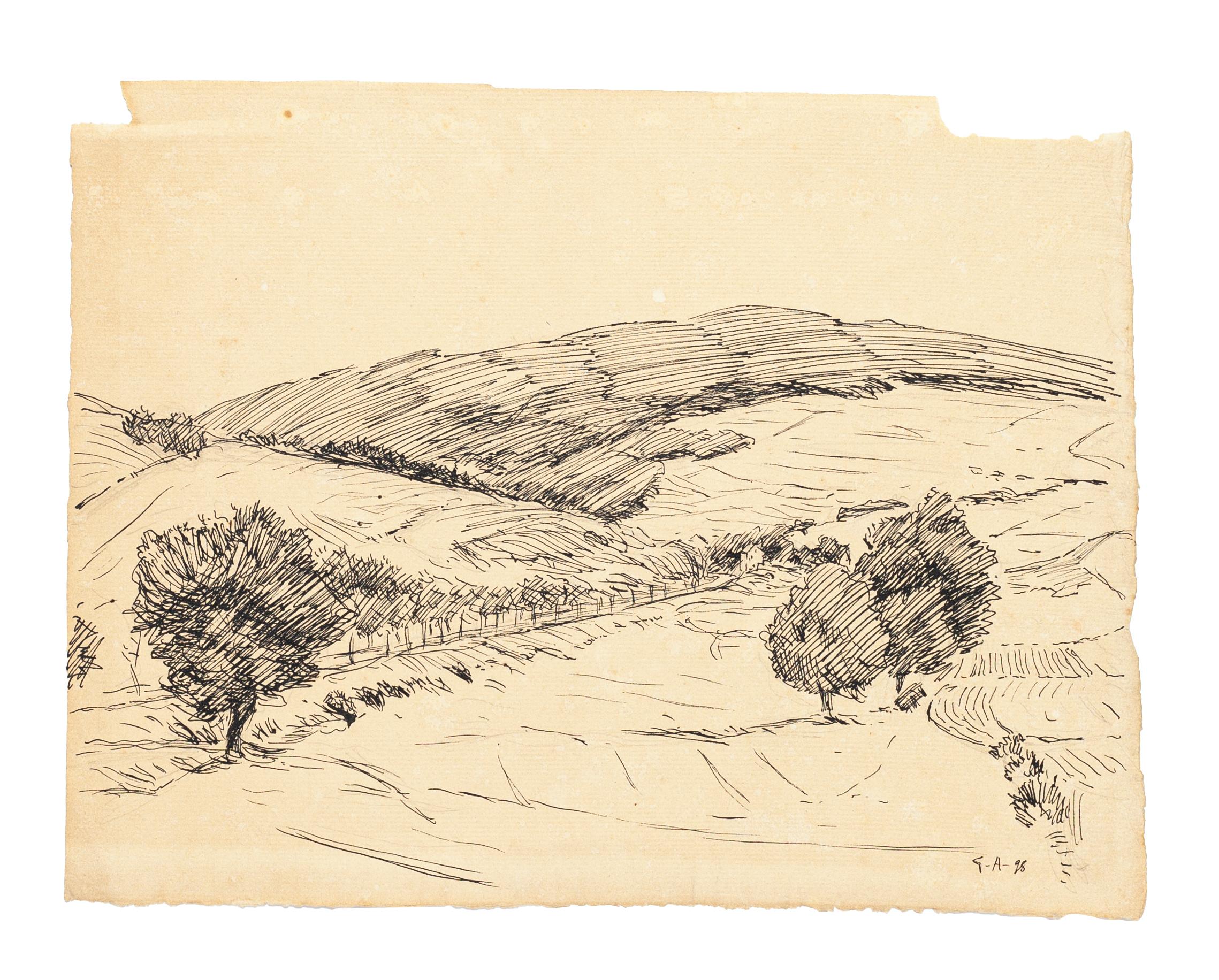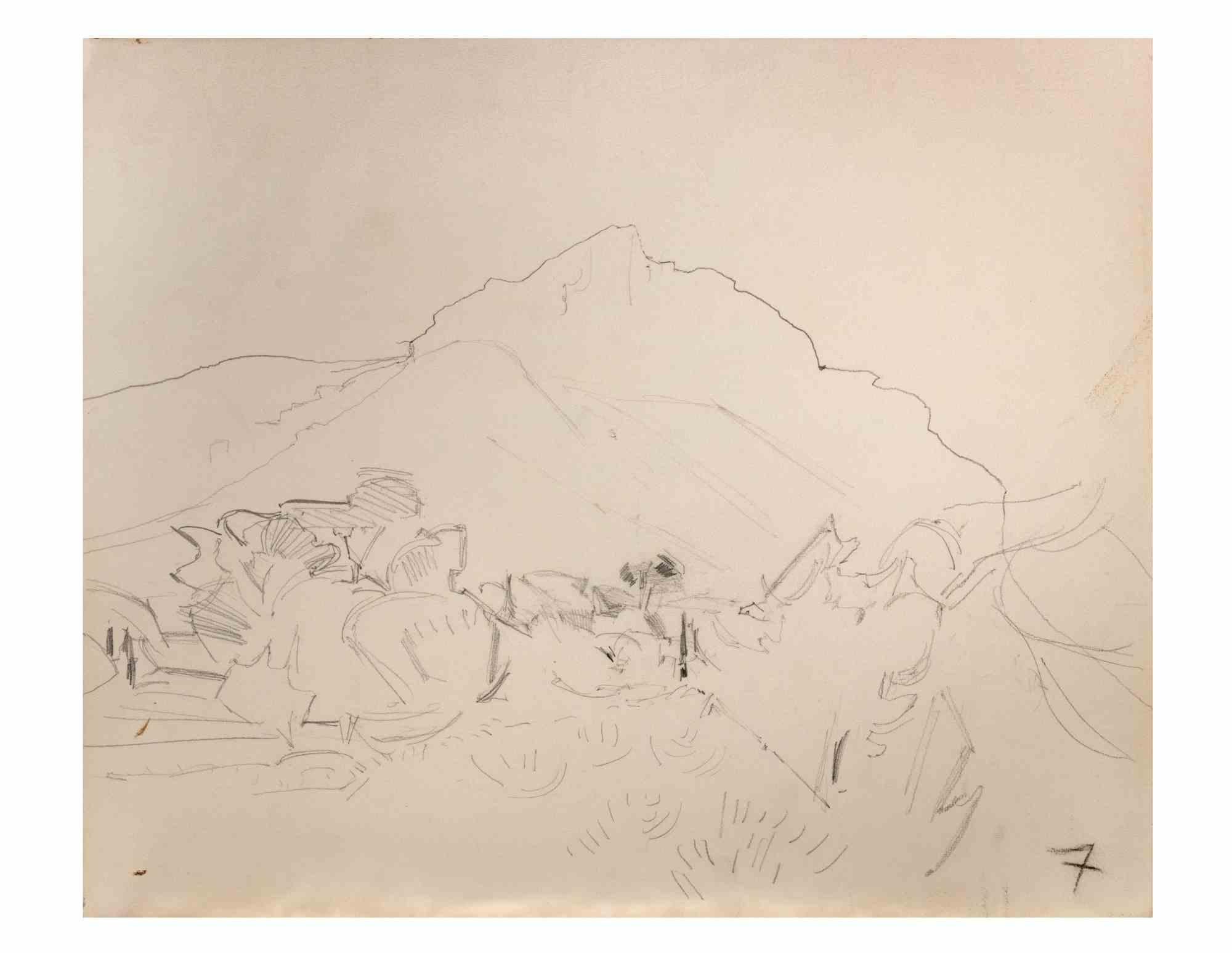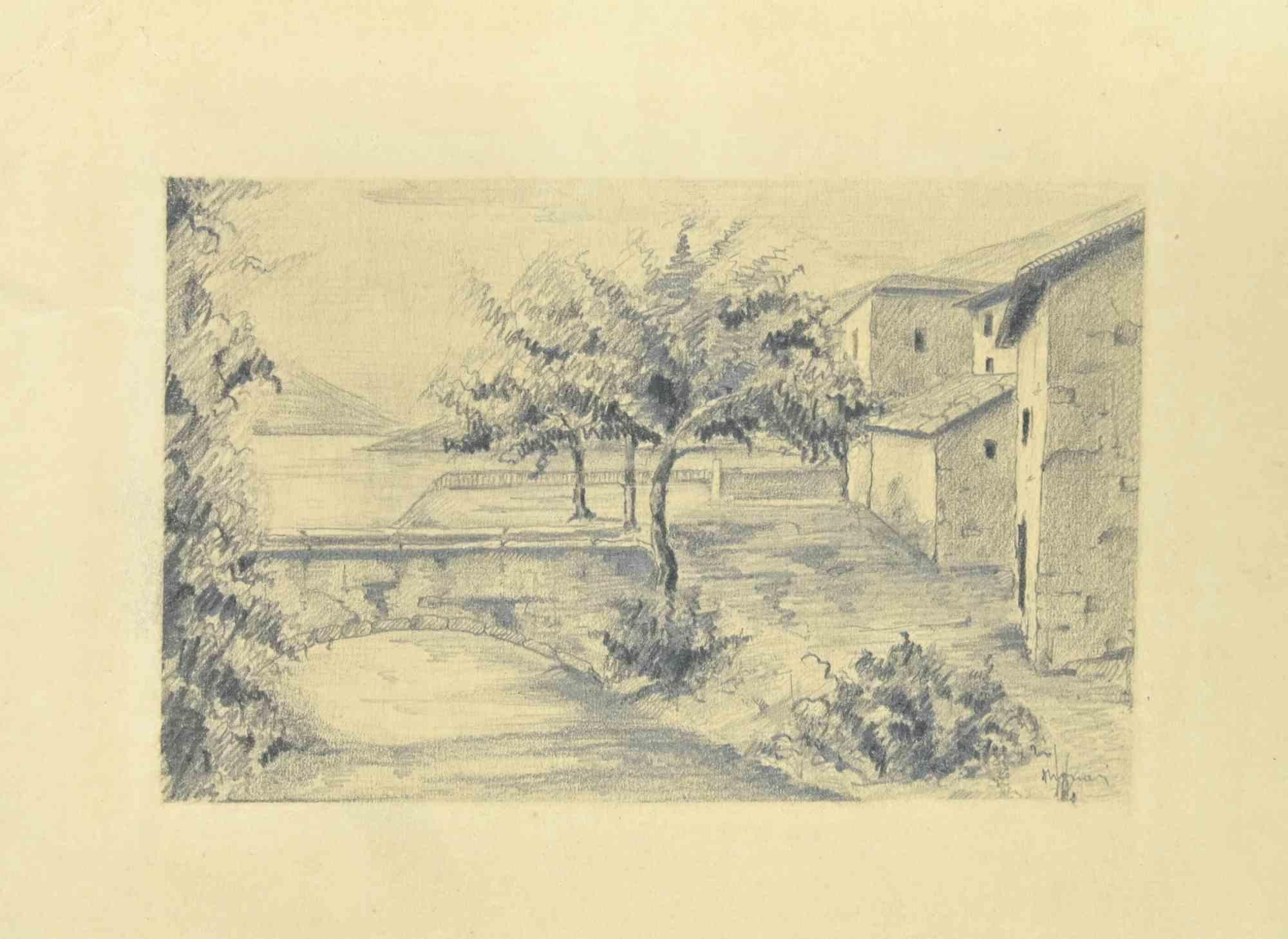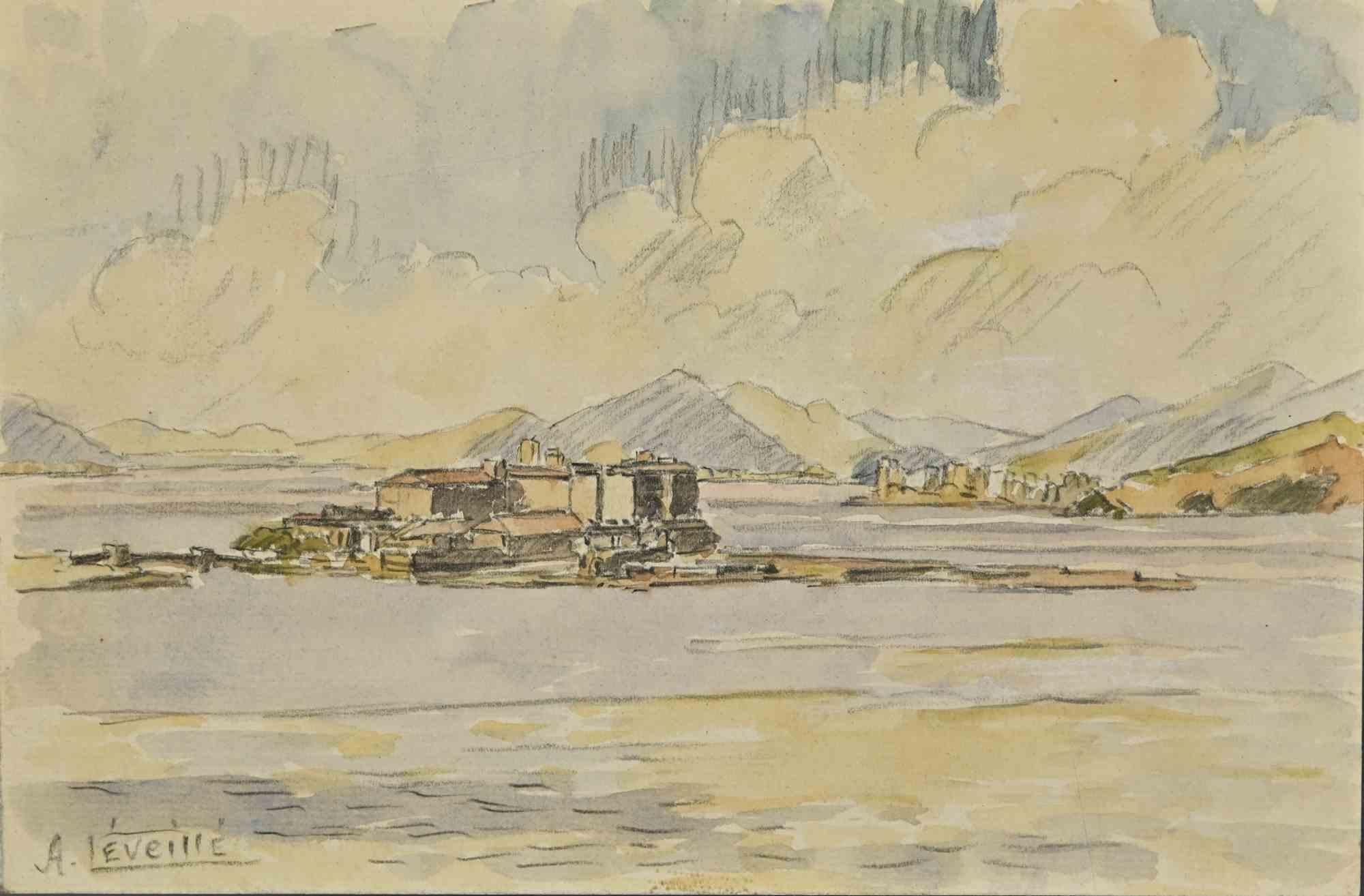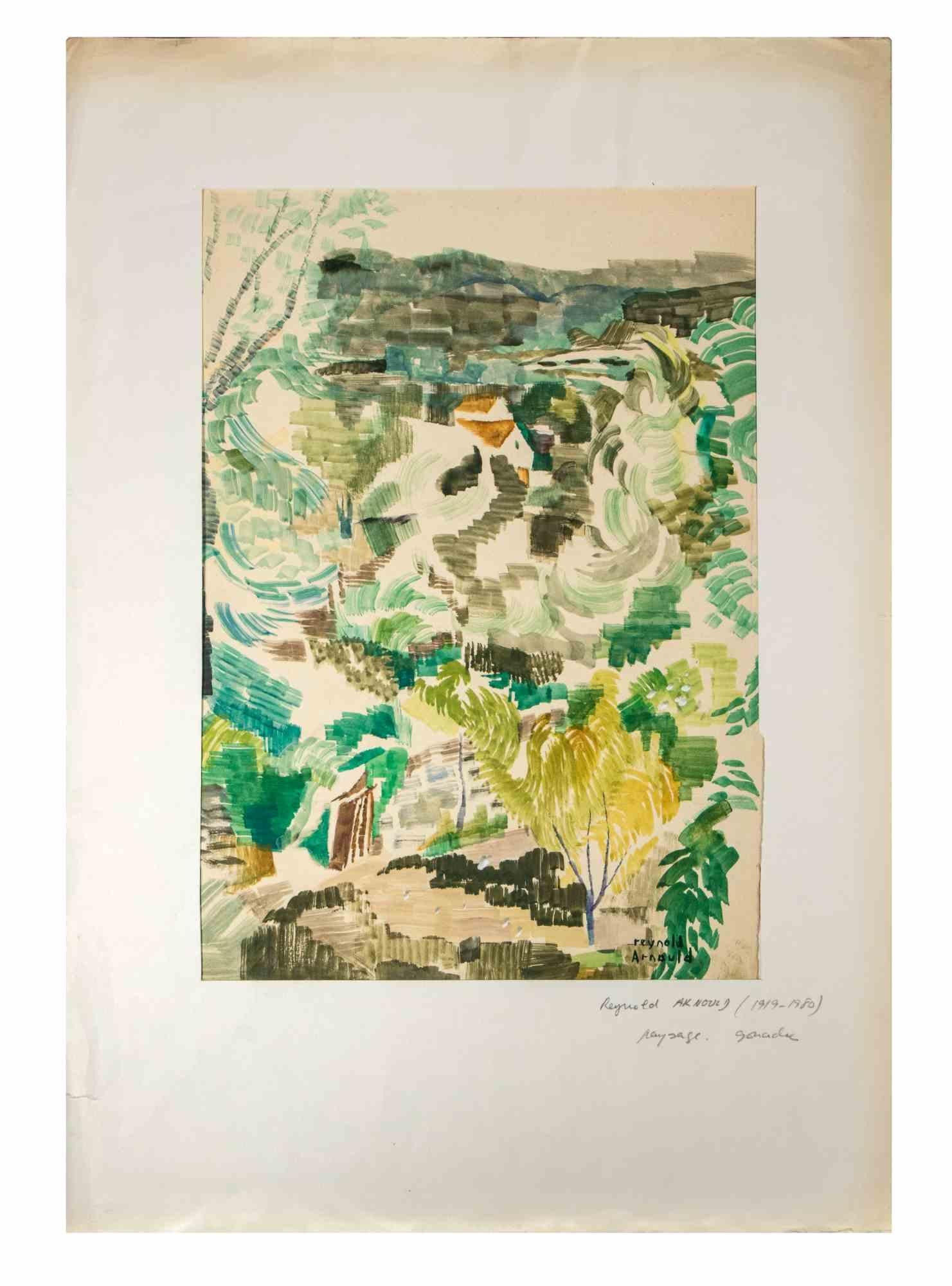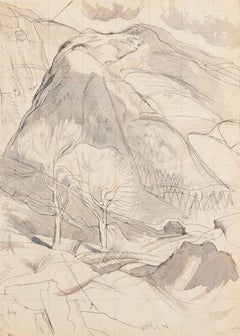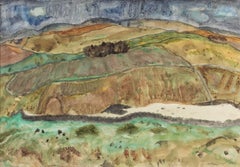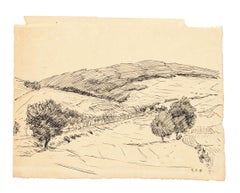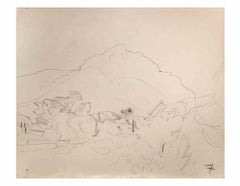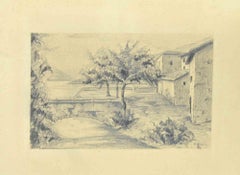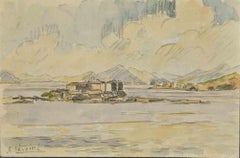Items Similar to Italian Landscape, Pen Painting by Reginald Brill, 1950 circa
Want more images or videos?
Request additional images or videos from the seller
1 of 3
Reginald BrillItalian Landscape, Pen Painting by Reginald Brill, 1950 circa1950 circa
1950 circa
$1,169.95
£850
€996.34
CA$1,597.21
A$1,776.83
CHF 931.44
MX$21,712.42
NOK 11,860.68
SEK 11,165.19
DKK 7,437.28
Shipping
Retrieving quote...The 1stDibs Promise:
Authenticity Guarantee,
Money-Back Guarantee,
24-Hour Cancellation
About the Item
Italian Landscape, Pen Painting by Reginald Brill, 1950 circa
Additional information:
Medium: Ink
20 x 34 cm
7 7/8 x 13 3/8 in
Reginald " Reggie" Brill was a versastile 20th century artist and teacher.
Brill was born in London in 1902 and spent his early childhood there and in Yorkshire. By the time of the First World War, at the age of 13, he was living in lodgings in London, working in a City office and attending St Martins School of Art in the evenings. Considering his lack of education, winning a scholarship to The Slade (now part of University College London) in 1921 where he studied under Henry Tonks for three years, was a huge achievement.
On leaving The Slade he found patronage in Lincolnshire, but by the time of the General Strike (1926) he had returned to London and was working on Lansbury's Labour Weekly. He married Rosalie, also an artist, and in 1927 won the Prix de Rome in Decorative Painting. Following two years at The British School in Rome, Brill went to teach at Blackheath School of Art. During 1930 he spent three months painting in Egypt and it was there that he met Col. T G Gayer-Anderson, one of the twin brothers who were to bequeath The Little Hall in Lavenham as a hostel for art students. It was there that Brill retired to act as warden, thus continuing his nurturing of art students until his death in 1972.
Brill took up his appointment at The School of Art, Kingston upon Thames in January 1934. It was situated in the Technical Institute (Kingston Hall Road) and Brill found it bohemian and disorganised. He proceeded to inject enthusiasm, order and discipline. Within 5 years of his appointment a purpose-built School of Art was opened in Knights Park. It remained open throughout the war and by 1945 there was a waiting list for places. Under the skilled and totally dedicated direction of Brill, Kingston School of Art became established with national reputation for excellence. In 1961 Sir Charles Wheeler opened the new building at Knights Park. Costing £100,000, this more than doubled the size of the Art School.
Brill, was a well-known figure in Kingston. His eloquence made him popular as a guest speaker and his promotion of Art and Design stretched well beyond the doors of Knights Park. Apart from establishing two of the main buildings which makeup what is now known as the Faculty of Design, one of the most visible local contributions he made was the setting up of a topographical collection of paintings depicting Kingston, which has since become known as The Brill Collection at Kingston Museum. Brill gained huge respect and admiration from the hundreds of pupils who studied at Kingston during his 30-year leadership.
He published two books, Modern Painting 1946 and Art as a Career 1962, both bearing a strong educational angle. He regularly exhibited along with leading artists of his era at The Royal Academy, both his paintings and his acutely observed drawings. All the while he was a prolific artist, although reading his diaries, intensely self-critical. His perfectionism, acute powers of observation and relentless research can be seen in his drawings, which via the media and methods he explored throughout his life reflect mid 20th century British Art at its most typical. His major series of work, known as 'The Martyrdom of Man', was carried on in parallel to his career as a teacher. These paintings reflect his care for fellow man and depict people at work, e.g., The Operation, The Jury, Linemen, Waiting Room and Rest, which recently sold at Sotheby’s and was specially restored for The Brill Retrospective. His smaller works also play with the theme of everyday events and communication amongst people, such as The Bull Ring and Market Place paintings.
Brill's name is associated particularly with human figure compositions, but he also worked on landscapes, portraits and details of plants, animals, interiors etc. As one would expect he moved from one media to another, and his unusual hand painted and cut paper mosaics are beautifully designed and worked. The Englishness of his work, with its narrative theme and the emphasis on people in their environment, combined with his interest and concern in human behaviour results in a legacy of excellence as yet unexploited.
- Creator:Reginald Brill (1902 - 1974, English)
- Creation Year:1950 circa
- Dimensions:Height: 7.875 in (20.01 cm)Width: 13.375 in (33.98 cm)
- Medium:
- Period:
- Condition:
- Gallery Location:Kingsclere, GB
- Reference Number:1stDibs: LU2718214573422
About the Seller
No Reviews Yet
Vetted Professional Seller
Every seller passes strict standards for authenticity and reliability
Established in 2010
1stDibs seller since 2024
40 sales on 1stDibs
Typical response time: 14 hours
- ShippingRetrieving quote...Shipping from: Kingsclere, United Kingdom
- Return Policy
Authenticity Guarantee
In the unlikely event there’s an issue with an item’s authenticity, contact us within 1 year for a full refund. DetailsMoney-Back Guarantee
If your item is not as described, is damaged in transit, or does not arrive, contact us within 7 days for a full refund. Details24-Hour Cancellation
You have a 24-hour grace period in which to reconsider your purchase, with no questions asked.Vetted Professional Sellers
Our world-class sellers must adhere to strict standards for service and quality, maintaining the integrity of our listings.Price-Match Guarantee
If you find that a seller listed the same item for a lower price elsewhere, we’ll match it.Trusted Global Delivery
Our best-in-class carrier network provides specialized shipping options worldwide, including custom delivery.More From This Seller
View AllItalian Scene, Pen and Ink with Wash Painting by Reginald Brill, 1950s circa
By Reginald Brill
Located in Kingsclere, GB
Italian Scene, Pen and Ink with Wash Painting by Reginald Brill, 1950s circa
Additional information:
Medium: Pen and ink with wash
33 x 48.3 cm
13 x 19 in
Reginald " Reggie" Brill was a versastile 20th century artist and teacher.
Brill was born in London in 1902 and spent his early childhood there and in Yorkshire. By the time of the First World War, at the age of 13, he was living in lodgings in London, working in a City office and attending St Martins School of Art in the evenings. Considering his lack of education, winning a scholarship to The Slade (now part of University College London) in 1921 where he studied under Henry Tonks for three years, was a huge achievement.
On leaving The Slade he found patronage in Lincolnshire, but by the time of the General Strike (1926) he had returned to London and was working on Lansbury's Labour Weekly. He married Rosalie, also an artist, and in 1927 won the Prix de Rome in Decorative Painting. Following two years at The British School in Rome, Brill went to teach at Blackheath School of Art. During 1930 he spent three months painting in Egypt and it was there that he met Col. T G Gayer-Anderson, one of the twin brothers who were to bequeath The Little Hall in Lavenham as a hostel for art students. It was there that Brill retired to act as warden, thus continuing his nurturing of art students until his death in 1972.
Brill took up his appointment at The School of Art, Kingston upon Thames in January 1934. It was situated in the Technical Institute (Kingston Hall Road) and Brill found it bohemian and disorganised. He proceeded to inject enthusiasm, order and discipline. Within 5 years of his appointment a purpose-built School of Art was opened in Knights Park. It remained open throughout the war and by 1945 there was a waiting list for places. Under the skilled and totally dedicated direction of Brill, Kingston School of Art became established with national reputation for excellence. In 1961 Sir Charles Wheeler opened the new building at Knights Park. Costing £100,000, this more than doubled the size of the Art School.
Brill, was a well-known figure in Kingston. His eloquence made him popular as a guest speaker and his promotion of Art and Design stretched well beyond the doors of Knights Park. Apart from establishing two of the main buildings which makeup what is now known as the Faculty of Design, one of the most visible local contributions he made was the setting up of a topographical collection of paintings depicting Kingston, which has since become known as The Brill Collection at Kingston Museum. Brill gained huge respect and admiration from the hundreds of pupils who studied at Kingston during his 30-year leadership.
He published two books, Modern Painting 1946 and Art as a Career 1962, both bearing a strong educational angle. He regularly exhibited along with leading artists of his era at The Royal Academy, both his paintings and his acutely observed drawings. All the while he was a prolific artist, although reading his diaries, intensely self-critical. His perfectionism, acute powers of observation and relentless research can be seen in his drawings, which via the media and methods he explored throughout his life reflect mid 20th century British Art at its most typical. His major series of work, known as 'The Martyrdom of Man', was carried on in parallel to his career as a teacher. These paintings reflect his care for fellow man and depict people at work, e.g., The Operation, The Jury, Linemen, Waiting Room and Rest, which recently sold at Sotheby’s and was specially restored for The Brill Retrospective. His smaller works also play with the theme of everyday events and communication amongst people, such as The Bull Ring and Market Place paintings.
Brill's name is associated particularly with human figure compositions, but he also worked on landscapes, portraits and details of plants, animals, interiors etc. As one would expect he moved from one media to another, and his unusual hand painted and cut paper mosaics...
Category
20th Century Landscape Paintings
Materials
Pen
Mountain Landscape, Pen and Ink Drawing by John Nash, 1950s, Double-sided
By John Nash
Located in Kingsclere, GB
Mountain Landscape, Pen and Ink Painting by John Nash 1893-1977, circa 1950
Additional information:
Medium: Pen and ink, with another pen and ink with watercolour verso
29 x 21 cm
1...
Category
20th Century Landscape Paintings
Materials
Pen
Pastoral Landscape, Gouache and Watercolour Painting by Alan Reynolds, 1953
By Alan Reynolds
Located in Kingsclere, GB
Pastoral Landscape, Gouache and Watercolour Painting by Alan Reynolds, 1953
Additional information:
Medium: Gouache and watercolour
19.5 x 27.5 cm
7 5/8...
Category
20th Century Abstract Drawings and Watercolors
Materials
Gouache
On the Meldons Road, Watercolour Painting by William George Gillies, circa 1940s
Located in Kingsclere, GB
On the Meldons Road, Watercolour Painting by William George Gillies, circa 1940s
Additional information:
Medium: Watercolour
41.5 x 59 cm
16 3/8 x 23 1/4 in
Signed
William George G...
Category
20th Century Landscape Drawings and Watercolors
Materials
Watercolor
Coastal Scene, Gouache Painting by Peter Potworowski, 1950s circa
Located in Kingsclere, GB
Coastal Scene, Gouache Painting by Peter Potworowski, 1950s circa
Additional information:
Medium: Gouache
17 x 21.5 cm
6 3/4 x 8 1/2 in
Tadeusz Piotr (Peter) Potworowski was a Polish abstract and figurative painter who lived and exhibited in Paris, Poland, Sweden and England.
Potworowski was born in Warsaw in 1898. After serving in the First World War, Potworowski enrolled at the Warsaw University of Technology to study architecture, though his studies were halted by the Bolshevik campaign. After the end of the Polish-Soviet War in 1921, Potworowski returned to Warsaw and began to study art at the school of Konrad Krzyżanowski. By the following year, he had taken a place at the Academy of Fine Arts in Krakow, where he studied under Józef Pankiewicz. It was Pankiewicz who incorporated Potworowski into the Paris Commute, or Kapists, a group of Polish artists who travelled to the French capital in 1924.
During his seven years in Paris he became personally acquainted with Pablo Picasso, Pierre Bonnard, Jean Cocteau, Constantin Brancusi and attended for a short time Fernand Léger's studio. It was through this job that he met his first wife Magdalena Mańkowska, a student of anthropology in Paris. After marrying in France, and visiting Britain in 1928, the couple returned to Poland in 1930, where their first son John was born.
In 1931, Warsaw was the locale of the first Kapists exhibition, entitled New Generation, which took place at the Artist's Club, Hotel Polonia, and the Institute of Art Propaganda. Here, Potworowski received a prize for his painting Three Women in the Interior. The following year, he held his first solo exhibition at the Makowski Salon in Poznań. This success was sustained through 1937 when the artist received a silver medal at the International Exhibition of Art and Technology in Paris, as well as the award from the Minister of Foreign Affairs. After this strong development, Potworowski had a travelling solo exhibition arranged, held in 1938 at the Institute of Propaganda of Art in Warsaw and then in Lviv.
Following the invasion of Poland in 1939, Potworowski escaped to Sweden via Lithuania. It was from here that the artist, with his wife and two young children, made his way to Britain, arriving in 1943. After serving in Scotland, Potworowski settled in London, and in January 1946, an exhibition of 33 of his works was held at the Redfern Gallery. This was followed by regular exhibitions with the Redfern, Gimpel Fils (1948 onwards) and The London Group, to which he was elected a member in 1949. He was also the president of the Association of Polish Artists and published regularly in the monthly magazine "Nowa Polska".
Potworowski's teaching career included eight years as Professor of Painting at the Bath Academy of Art, Corsham (1949-57), where he had considerable European influence, specifically on abstraction, and was acknowledged by contemporaries including Peter Lanyon, Bryan Wynter...
Category
20th Century Abstract Paintings
Materials
Gouache
Painswick, Watercolour Over Pencil Painting by Charles March Gere, 1930s circa
By Charles March Gere, RA, RWS
Located in Kingsclere, GB
Painswick, Watercolour Over Pencil Painting by Charles March Gere, 1930s circa
Additional information:
Medium: Watercolour over pencil
15.5 x 29.5 cm
6 1/8 x 11 5/8 in
Signed and titled verso
Charles March Gere RA RWS was an English painter, illustrator of books, and stained glass and embroidery designer associated with the Arts and Crafts movement.
He painted his signal work in 1897 entitled The Lady of Grey Days.The painting was purchased in 1912 and given to Aurora Howard, a descendant of the Earl of Carlisle (of Castle Howard). It was last seen...
Category
20th Century Landscape Drawings and Watercolors
Materials
Watercolor
You May Also Like
Landscape - Original Pen Drawing - Mid 20th Century
Located in Roma, IT
Landscape is an original drawing in pen on paper realized by an Anonymous artist of the 20th century. With monogram of the artist on the lower right in pen.
The State of preservatio...
Category
1950s Figurative Drawings and Watercolors
Materials
Pen
Landscape - Drawing By Reynold Arnould - Mid-20th Century
Located in Roma, IT
Landscape is a pencil drawing realized by Reynold Arnould (Le Havre 1919 - Parigi 1980).
Good condition on a yellowed paper, no signature.
Reynold Arnould was born in Le Havre, Fr...
Category
Mid-20th Century Modern Landscape Drawings and Watercolors
Materials
Pencil
Landscape - Drawing by Augusto Monari - Early-20th Century
Located in Roma, IT
Landscape is a pen cil drawing realized by Augusto Monari in the Early-20th Century. Signed lower right.
Good conditions.
The artwork is depicted th...
Category
Early 20th Century Modern Figurative Drawings and Watercolors
Materials
Pencil
Landscape - Drawing by André Léveillé - Mid-20th Century
Located in Roma, IT
Landscape is a drawing realized by André Léveillé (1880-1962) in the early 20th Century.
Charcoal and watercolor on paper.
Good conditions with slight foxing.
The artwork is reali...
Category
Mid-20th Century Modern Landscape Drawings and Watercolors
Materials
Charcoal
Landscape - Drawing By Reynold Arnould - Mid-20th century
Located in Roma, IT
Landscape is a Gouache on paper realized by Reynold Arnould (Le Havre 1919 - Parigi 1980).
Good condition, included a white cardboard passpartout (54x37.5 cm).
Hand-signed by the ...
Category
Mid-20th Century Modern Landscape Drawings and Watercolors
Materials
Paper, Gouache
Landscape - China ink Drawing by Renzo Vespignani - 1949
By Renzo Vespignani
Located in Roma, IT
Landscape is an original drawing in China ink on paper realized in 1949 by Renzo Vespignani.
Hand-signed on the lower left and date.
Applied on a Passepartout: 21 x 15.5 cm.
Very...
Category
1940s Modern Landscape Drawings and Watercolors
Materials
Ink
More Ways To Browse
Man Reading Painting
1950 Interior Door
Lincolnshire Painting
Mid Century Painting By Anderson
T Powers
Bull Ring
Vintage College Ring
1921 Ring
Vintage English Wheel
1934 Ring
Charles E Martin
Vintage Stretch Rings
Vintage 3 Speakers
Vintage 1950 Makeup
Antique Breton
Pueblo Art
Landscape Painting Stone Wall
Venice Bridge
